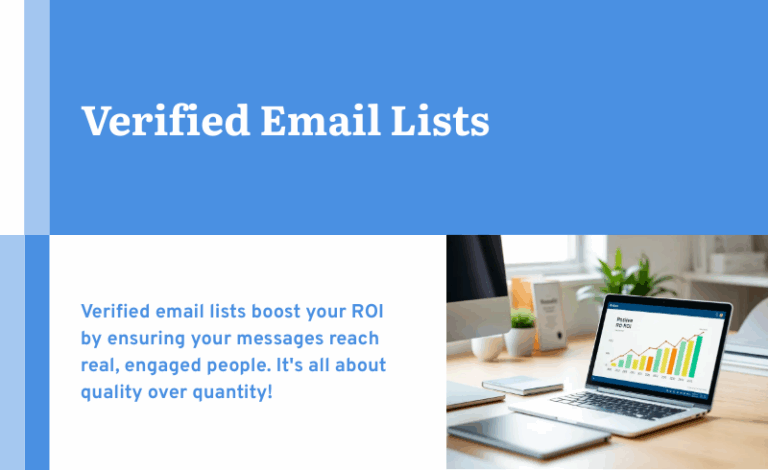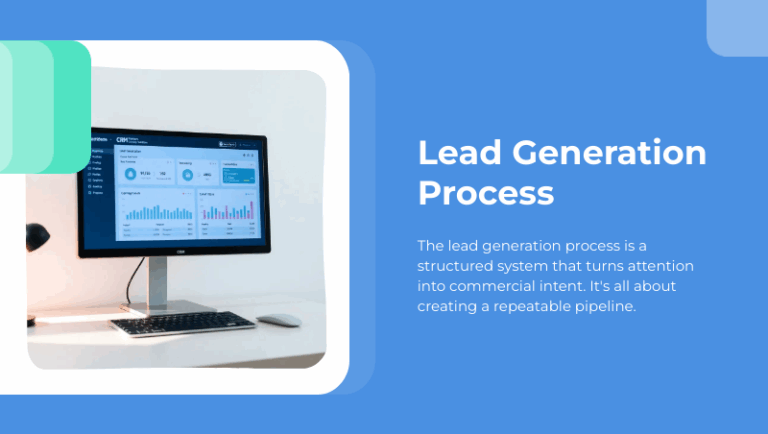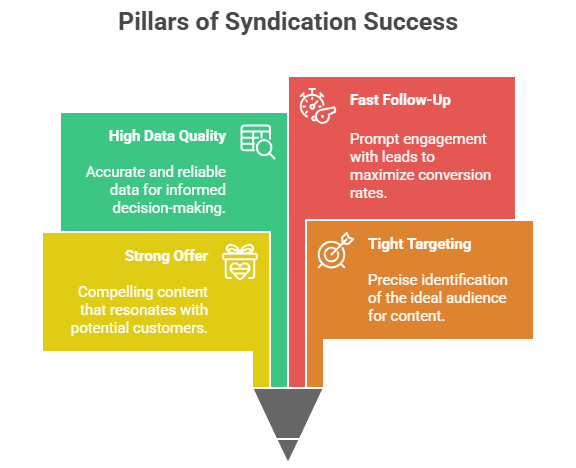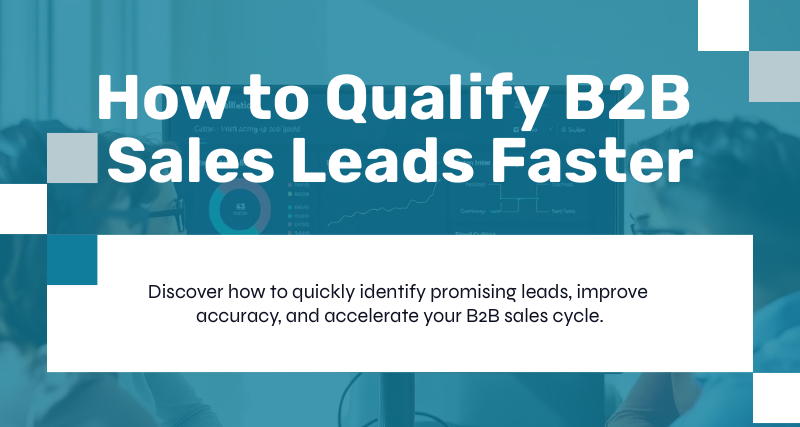
Why Faster B2B Lead Qualification Is Now a Competitive Imperative
In B2B lead generation, the rapid identification of promising leads from irrelevant ones is paramount for successful deal closure. Contemporary buyers are notably well-informed and discerning, frequently conducting substantial research prior to engaging with a sales team. This trend significantly reduces the timeframe available to capture their interest and facilitate a sale.
The essential element is not merely speed, but rather streamlined precision. This entails efficiently determining which leads merit attention and which should be disregarded. When executed effectively, expedited qualification elevates quality by concentrating efforts on the most valuable opportunities.
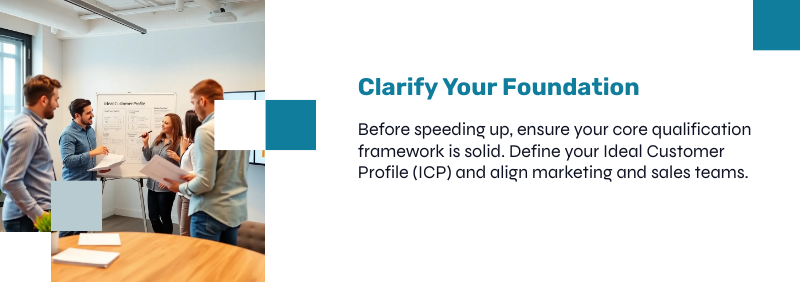
Step 0: Clarify Your Foundation (Before Speeding Up)
You can’t accelerate a broken engine. Before you streamline, make sure your core qualification framework is solid.
1. Define a rigorous Ideal Customer Profile (ICP)
Your ability to qualify quickly depends on how clearly you know who isn’t a fit. The tighter your ICP, the less ambiguity your SDRs have.
Key dimensions often include:
- Vertical / industry
- Company size / revenue / headcount
- Geography
- Buying triggers / use cases
- Budget ranges
- Technological maturity / stack
Without a sharp ICP, every lead will feel “maybe,” and speed becomes guesswork.
2. Align Marketing & Sales on qualification criteria
Disjointed definitions between MQL (Marketing Qualified Lead) and SQL (Sales Qualified Lead) slow things. Ensure both teams agree:
- What behaviors or signals elevate a lead from MQL → SQL
- What disqualifiers should terminate follow-up
- What minimal data must exist (e.g. revenue estimate, decision-maker name)
This synchronization reduces friction at handoff, a frequent bottleneck.
3. Create a qualification “checklist” or rubric
Whether via BANT, MEDDIC, CHAMP, or your custom variant, your qualification process should map directly to a repeatable checklist:
- Budget — do they have the means?
- Authority — who can sign off?
- Need — is the pain real and felt now?
- Timeline / urgency
- Fit (product/solution alignment)
- Competitive context / use of alternatives
When your reps have a shared, explicit rubric, they waste less time debating.
Once those foundational elements are clear, you’re ready to layer in acceleration techniques.
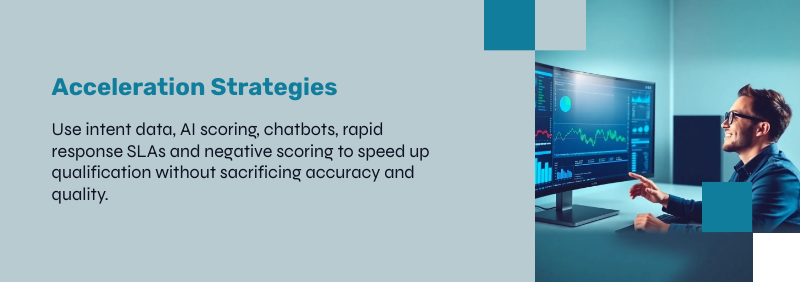
Acceleration Strategies: Qualify Leads Faster Without Cutting Corners
Here are proven levers to speed up qualification while maintaining (or even improving) accuracy.
1. Use intent & trigger data early on
Instead of waiting for a lead to engage deeply, tap into signals that suggest a prospect is already researching.
- Third-party intent data (e.g., from Bombora, G2, 6sense) can show which companies are searching for your category, keyword, or competitive alternatives.
- On-site behavior triggers — e.g. visiting your pricing page, downloading ROI calculator, repeated product pages.
- Firmographic & technographic triggers — e.g. tech stack changes, funding events, hiring surges.
Many teams report that integrating intent signals increases qualification accuracy by 77 %.
You can score early-stage leads by combining intent with ICP fit to accelerate handoff to SDRs or sales.
2. Layer in AI and predictive scoring
Modern AI tools can dramatically accelerate lead scoring, making fast triage possible.
- Systems that ingest behavior, firmographic, technographic, and engagement data can predict likelihood to convert more precisely than human-only scoring.
- These models can re-score leads in real time as new activity comes in, surfacing hot leads early.
- Some research suggests AI-powered lead qualification can improve closing ratios by up to 40 %.
In practice:
- Use AI models to assign a dynamic “priority score” and route leads automatically.
- Combine that with manual override or checkpoints for deals that don’t neatly conform.
- Continuously retrain models based on closed vs lost deals to reduce bias and drift.
3. Automate the initial “qualification conversation”
Don’t let every lead require a full manual outreach immediately. Use automation to filter faster:
- Chatbots or conversational forms that ask 2–3 qualification questions (e.g. budget, timeline, company size)
- Interactive tools or calculators that require inputs tied to qualification
- Pre-call email sequences that ask validation questions
This front-line automation prevents your reps from doing low-value work. It also pushes leads further through your funnel based on their own responses.
4. Implement a rapid-rotation “first response” system
The faster a lead hears from you, the better. Some best practices:
- Set SLA rules: e.g. outreach within 5 minutes of lead submission
- Use trigger-based workflows to push leads to SDRs or autoresponders
- Monitor queue times and reassign leads if they sit too long
Statistically, responding within minutes rather than hours can spike conversion probabilities.
5. Add negative scoring / “disqualify fast” signals
Speed also comes from knowing when not to engage. Define clear disqualifiers to weed out low-value leads:
- Company size under minimum
- Unaligned industry
- No decision-maker or contact info
- Reliance on non-compatible systems
- Budget outside acceptable range
In your lead scoring model, assign negative weight to disqualifiers so they drop out early.
6. Use progressive profiling to fill gaps over time
Rather than demanding full information upfront, capture minimal viable data and then enrich gradually:
- Collect basic firmographic data first
- Use outreach or nurture to ask for missing fields
- Append via data providers (e.g. ZoomInfo, Clearbit)
- Drop leads where critical fields remain missing after a threshold
This preserves speed in early stages while reducing friction.
7. Prioritize accounts (vs individual leads) using Account-Based approaches
Instead of evaluating leads in isolation, treat qualification through an account lens:
- Rank target accounts via ICP fit, deal size, strategic value
- Use engagement from any contact in that account to surface opportunities
- Consolidate lead scores at account-level to avoid duplicative efforts
ABM also reduces noise — you focus on fewer, higher-probability accounts rather than chasing every inbound.
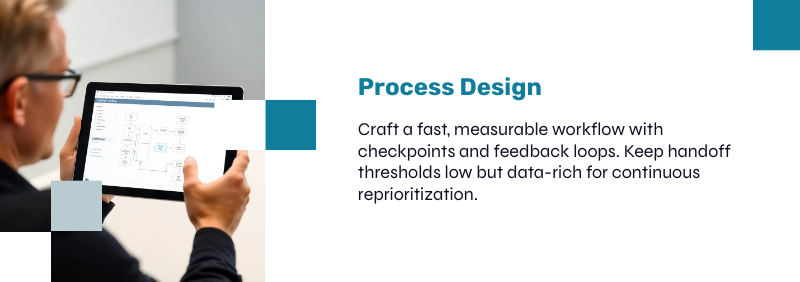
Process Design: How to Build a Fast, Reliable Qualification Workflow
Here’s a sample end-to-end process you can operationalize:
| Stage | Activity | Tool / Tactic | Timing / SLA | Output / Decision |
| Lead capture | inbound form, campaign response, third-party list | require minimal fields (name, company, email, role) | immediate | initial lead record |
| Early triage | assign ICP-fit score + intent signal match | predictive scoring engine | real time | leads get flagged “low / medium / high priority” |
| Automated screening | chatbot / email sequence asks key qualification questions | conversational flows | within minutes | disqualify, nurture, or qualify |
| SDR quick screen | SDR does a 5–10 min discovery call or probe | use checklist rubric | same day | lead → SQL or disqualify or continue nurture |
| Hand-off / routing | Convert SQL → assign to sales rep or queue | automation rules + alerts | minutes | opportunity moves into pipeline |
| Ongoing re-scoring | Lead behavior continues to feed re-scoring model | AI / predictive model | continuous | reprioritize, re-qualify, or de-escalate |
To accelerate:
- Keep handoff thresholds low but data-rich (i.e. don’t wait for perfect info)
- Use parallel workstreams (e.g. smart bots + SDR triage)
- Instrument every stage with metrics (latency, conversion, disqualification rate)
- Iterate quickly — A/B test qualification scripts, bot flows, scoring thresholds
Common Pitfalls & How to Avoid Them
Even with great systems, teams slip into traps. Here are the common ones:
- Over-scoring everything
If you weight too many minor signals heavily, your model becomes noisy. Keep your “must-haves” dominant. - Black-box models with no explainability
If reps don’t trust the AI’s recommendations or can’t see why a lead was scored, they’ll ignore or override it. - Misaligned incentives
If SDRs or marketers are rewarded by volume rather than quality, they’ll push unqualified leads forward. - Qualification fatigue
Asking too many questions too early will deter prospects. Use progressive profiling and staged qualification. - Neglecting periodic recalibration
Markets shift; your ICP or ideal buyer characteristics evolve. Your scoring and rubric must evolve too.
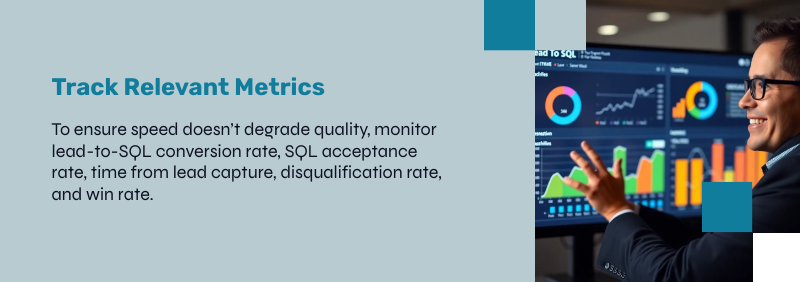
Metrics to Track (So You Know Speed Isn’t Coming at Cost)
To ensure speed doesn’t degrade quality, monitor:
- Lead-to-SQL conversion rate
- SQL acceptance / rejection rate (by sales reps)
- Time from lead capture → first SDR touch
- Time from SQL handoff → full opportunity creation
- Disqualification rate and reasons
- Win rate (% of SQLs closing)
- Average deal size / revenue per qualified lead
If you accelerate time but see quality drop (lower win rates or smaller deals), adjust your thresholds or scoring.
Summary & Key Takeaways
Qualifying B2B leads faster is less about shortcuts and more about precision, automation, and alignment. To do it well:
- Start with clarity: sharpen your ICP, align sales/marketing, and build a robust qualification rubric.
- Accelerate intelligently: use intent data, AI scoring, chatbots, rapid response SLAs, negative scoring, and ABM lens.
- Design a fast, measurable workflow with built-in checkpoints and feedback loops.
- Avoid pitfalls: don’t overcomplicate models, ignore recalibration, or misalign incentives.
- Monitor outcomes carefully: speed must not come at the cost of deal quality or win rates.
By combining human judgment with smart automation and data, you can transform your pipeline into a lean, high-velocity engine — not a clogged backlog.
FAQs: B2B Lead Qualification
1. “What are the best B2B lead scoring methods?”
Answer: For speed and accuracy, the most effective lead scoring method is a hybrid model that combines firmographic fit + behavioral signals + buyer intent — all dynamically weighted.
- Firmographic fit includes industry, company size, revenue range, and geographical footprint — the foundational “does this company belong in our world?” filter.
- Behavioral signals measure what the lead does: visits to pricing pages, content downloads, repeat site visits, email opens, webinar attendance.
- Intent / trigger data captures signals outside your funnel — search terms, third-party intent data, technographic changes, inbound searches on keywords aligned with your offering.
- Dynamic weighting / recency ensures that recent behavior is valued more highly than stale engagement.
Set a threshold score (e.g. 70/100) at which leads automatically move into human review — and continuously refine that threshold as more deals close or stall.
2. “What qualifying questions should I ask a prospect to move fast?”
Answer: Ask questions that zero in on pain, urgency, decision process, and value — but only those that aren’t easily researchable. Here’s a compact set of high-impact queries:
Need / Pain
- “What’s the top business challenge driving you to explore solutions now?”
- “If this problem isn’t solved in the next 3–6 months, what impact would that have?”
Decision & Stakeholders
- “Who, besides yourself, will be involved in the evaluation or approval process?”
- “What criteria will that group use to assess a potential solution?”
Budget & ROI
- “How do you normally measure success for projects like this (ROI, cost savings, revenue uplift)?”
- “Have you allocated a budget for solving this challenge — or is that still pending?”
Timing & Priority
- “What’s motivating this initiative now rather than later?”
- “On a scale of 1–5, how high a priority is this relative to other initiatives you’re managing?”
If a prospect hesitates or is vague on multiple fronts, that itself is useful signal — a soft disqualifier or a sign that more nurturing is required.
3. “How can CRMs help me qualify leads faster?”
Answer: A modern CRM is your scaffolding: it enables faster qualification by automating tasks, centralizing intelligence, and enforcing consistency.
- Automated scoring & tagging — leads are assessed immediately based on preset criteria, with flags or thresholds triggering actions.
- Enrichment workflows — missing fields (company size, tech stack, revenue) are auto-populated via enrichment tools so rep time is not spent chasing data.
- Conditional routing & SLAs — high-scoring leads get escalated automatically, with alerts or workflows to ensure rapid follow-up.
- Template & checklist enforcement — qualification fields and frameworks (BANT, MEDDIC, CHAMP) can be embedded in record layouts or forms so reps don’t skip steps.
- Visibility & dashboards — leaders monitor speed, conversion, disqualification patterns, helping them spot bottlenecks or misweighted signals early.
Together, these CRM features reduce manual friction and accelerate the assessment-to-handoff path.
4. “Which lead qualification framework should I use — BANT, MEDDIC, CHAMP, or others?”
Answer: There’s no one-size-fits-all. Use a tiered approach:
- Top-level filter (fast, light): Use BANT or CHAMP to quickly weed out obviously unqualified leads (budget, authority, challenge, priority). This helps you act fast.
- Mid-to-late funnel (deeper vetting): Shift into richer frameworks like MEDDIC / MEDDPICC which demand deeper insight into metrics, decision criteria, internal champions, and buying process complexity.
In practice, early-stage conversations rely more heavily on CHAMP (start with challenge / priority) while pipeline validation leverages MEDDIC’s deeper rigor.
5. “How fast should I respond and qualify a lead?”
Answer: Your speed matters more than you think. Ideal benchmarks are:
- Initial outreach: within 5–15 minutes of lead capture. Every minute of delay increases lead cooling dramatically.
- First human qualification touch (SDR/rep): same business day, ideally within 1–4 hours.
- Full triage to SQL / disqualification: within a few hours, not days.
When leads sit untouched for 24 hours, momentum stalls, context shifts, and competing offers gain advantage. Monitor queuing times and implement escalations if leads remain unassigned.
6. “What do you do with leads that don’t qualify yet?”
Answer: Unqualified doesn’t mean dead. What you do next should be intentional, not passive.
- Segment & nurture: move them into content tracks tailored to their gap (e.g. lack of urgency, no budget yet) with drip campaigns, case studies, education.
- Re-scoring over time: periodically reassess their fit as new behavior or signals emerge.
- Expiration logic: if a lead remains inactive or unresponsive after a defined window (e.g. 90 days), archive or remove it to declutter your system.
- Re-qualification checks: Execute light touches (e.g. “Has anything changed in your priorities or budget?”) to test renewed interest.
By actively managing non-qualified leads, you keep pipeline hygiene high without wasting potential future opportunities.
7. “What mistakes slow down B2B lead qualification — and how to avoid them?”
Answer: Even seasoned teams fall into traps. Watch out for these and correct them:
- Micromanaged scoring models: Overengineering your scoring with dozens of micro-factors dilutes focus and slows decisions.
- Black-box AI models without transparency: If reps don’t understand why a lead was flagged, they distrust and override it.
- Incentive misalignment: If reps are rewarded on quantity instead of quality, they’ll push weak leads forward.
- Asking too many qualifying questions too early: That overwhelms and turns off prospects.
- Stale or inconsistent data: Duplicate or missing information causes misrouting or delays.
- Neglecting regular recalibration: Market conditions, buyer behaviour, and your ICP evolve — your criteria should evolve too.
Avoiding these prevents speed from becoming recklessness.
